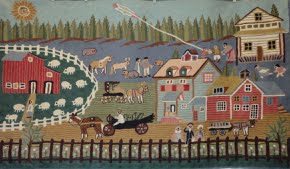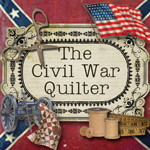How I got from Clara R. Brian to Richard Hofstadter!
Youngest daughter Lori studying an old embroider sampler my father found in the old family homeplace in the Shenandoah Valley after he inherited the house in 1974.
Youngest daughter Lori studying an old embroider sampler my father found in the old family homeplace in the Shenandoah Valley after he inherited the house in 1974.
I never know where my textile history research will lead me -- but for 30 years it has truly been an amazing journey of learning about subjects I never dreamed I might pursue.
Here is just one example of where my research on quilt pattern columns in newspapers in the 1930s led when I visited quilt historian Wilene Smith's Quilt History Tidbits -- Old & Newly Discovered website today.
Which then led to this web page about Clara Brian as a documentary
photographer:
QUOTE: When [photographer] Clara Brian began her education
in 1913 home economics was very new as a national movement. It was a time in
American society when, as Richard
Hofstadter described it, "that
broader impulse toward criticism and change that was everywhere so conspicuous
after 1900... effected in a striking way...the whole tone of American political
life." Americans had a feeling of evangelical optimism, the conviction
that by hard work and education, through the application of scientific
principles and with the spirit of sacrifice and cooperative action, people
could improve and reform society, each other, themselves, for a more spiritual
and idealized order.
Which then led to quotes from author Richard Hofstadter:
Which led to this QUOTE which sounds so much like our
political situation today:
“As a member of the avant-garde who is capable
of perceiving the conspiracy before it is fully obvious to an as yet unaroused
public, the paranoid is a militant leader. He does not see social conflict as
something to be mediated and compromised, in the manner of the working
politician. Since what is at stake is always a conflict between absolute good
and absolute evil, what is necessary is not compromise but the will to fight
things out to a finish. Since the enemy is thought of as being totally evil and
totally unappeasable, he must be totally eliminated–if not from the world, at
least from the theatre of operations to which the paranoid directs his
attention. This demand for total triumph leads to the formulation of hopelessly
unrealistic goals, and since these goals are not even remotely attainable,
failure constantly heightens the paranoid’s sense of frustration. Even partial
success leaves him with the same feeling of powerlessness with which he began,
and this in turn only strengthens his awareness of the vast and terrifying
quality of the enemy he opposes.”
― The Paranoid Style in American Politics and Other Essays
― The Paranoid Style in American Politics and Other Essays
All because I started studying Clara Brian who, for a short
time in the 1930s, wrote a newspaper quilt pattern column!
I love the serendipity and synchronicity of research!!!!






























































